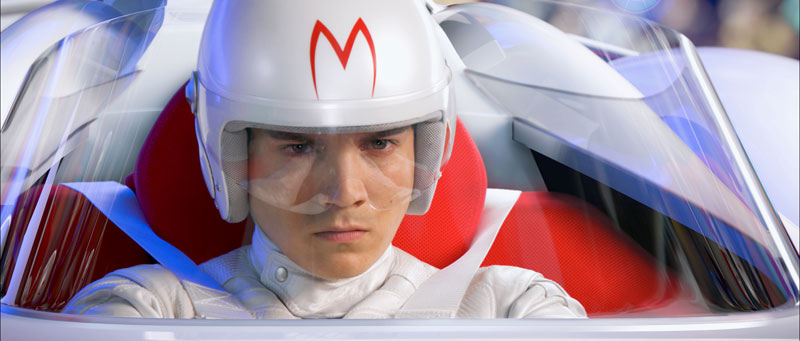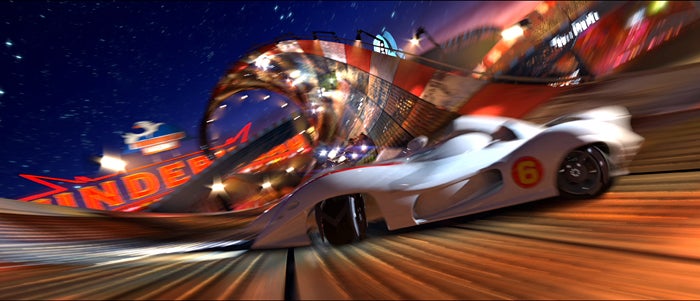← Back to Reviews
in
Speed Racer (Wachowski Bros., 2008)

First off, I want to say that I watched "Speed Racer" on TV in the '60s. I'll confess that I did it because my younger brother was a Superfan and he was only six years old! I had no problem watching it because it was fast-paced, most of the dubbed dialogue was screamed out rat-a-tat style, and it could sometimes make you laugh out loud*. It probably had less facial expression than almost anything I'd ever seen (except maybe "Clutch Cargo"), but heck, it was the first anime I was ever exposed to. Speed Racer always held the relationships of the family and team in high regard, but what I'm truly impressed about the Wachowskis' adaptation is that for all the visual spectacle on display, it's the relationships and the principles of the characters which make this Speed Racer worth watching.
I've read the reviews for Speed Racer at this site, and without referring to any names, I'll try to address some of the concerns expressed in them. However, one thing which isn't addressed in any of them I find to be interesting. When I first heard that Speed Racer was 135 minutes long, I asked myself why it would have to be any more than 95. Well, after watching the film, I know why. Speed Racer is presented as a "Super Hero" and thus, we're watching his origin tale. The Wachowskis must have believed that they were starting a franchise here, and although it tanked at the box office, I think the film is far better than its critical and popular reaction reflects. The Wachowskis' main influence, at least in all the non-racing scenes, seems to be Warren Beatty's Dick Tracy. The bright, primary color scheme is accented in all the interior shots. The racing scenes also use bright colors, but they seem to have many more hues and be more neon-like. In this way, the Wachowskis seem to emphasize something more closely related to comic books in the domestic scenes (as in something you'd see in a super hero comic), while promoting the kinetic surrealism of anime.

The Wachowskis do use a different editing technique for this film which has been commented upon in an earlier review. They pan across the screen, and whenever something comes across the foreground, you're in the next scene. The film which this seems to have been "inspired" by is Pan's Labyrinth; however, it's used much more often in this film. I'll admit that the editing of the opening scenes, while in no way that awkward or confusing, does get to be a bit repetitive. It does seem to improve as the film progresses and settles down into a calmer rhythm where the characters and their themes of personal responsibilty, abillity and morality seem to be much more-thoroughly explored. You see, although I was cheering for the good guys in this movie, it took the added length of the film for me to fully get behind them. The film seems to fly by its 135 minutes, and that's probably because even if it flowed smoothly during its first half (albeit coasting on spectacle and action), it went by twice as fast once you actually understood that you were watching a family who truly cared about each other and was going to go out of its way to correct any wrongs it had somehow enabled in the past.

OK, I'll admit that this may sound like I'm some kind of fan boy and/or fool, but Speed Racer is actually a really solid summer popcorn flick. It's not as deep or inspired as Iron Man, but it's not really that much less deep or inspired. It got shafted and deserves a reexamination or at least, a first chance. It certainly has flaws. It's actually a tad too serious, but the weakest parts are the silliest ones. It was almost as if the Wachowskis wanted to make Speed Racer more poignant, but they were worried that if they didn't include a few buffoonish scenes (the ninjas and some of the chimp scenes), that the kids wouldn't laugh and find the thing all too boring. The way the summer marketplace is stacked now, movies don't really have much of a chance to establish an audience before being unceremoniously booted away. I don't really believe that Speed Racer had much of a chance to find an audience, so it mostly failed on "pre-word of mouth" rather than the actual opinions of the paying public who saw it. It was just seen as a failure in advance.

First off, I want to say that I watched "Speed Racer" on TV in the '60s. I'll confess that I did it because my younger brother was a Superfan and he was only six years old! I had no problem watching it because it was fast-paced, most of the dubbed dialogue was screamed out rat-a-tat style, and it could sometimes make you laugh out loud*. It probably had less facial expression than almost anything I'd ever seen (except maybe "Clutch Cargo"), but heck, it was the first anime I was ever exposed to. Speed Racer always held the relationships of the family and team in high regard, but what I'm truly impressed about the Wachowskis' adaptation is that for all the visual spectacle on display, it's the relationships and the principles of the characters which make this Speed Racer worth watching.
I've read the reviews for Speed Racer at this site, and without referring to any names, I'll try to address some of the concerns expressed in them. However, one thing which isn't addressed in any of them I find to be interesting. When I first heard that Speed Racer was 135 minutes long, I asked myself why it would have to be any more than 95. Well, after watching the film, I know why. Speed Racer is presented as a "Super Hero" and thus, we're watching his origin tale. The Wachowskis must have believed that they were starting a franchise here, and although it tanked at the box office, I think the film is far better than its critical and popular reaction reflects. The Wachowskis' main influence, at least in all the non-racing scenes, seems to be Warren Beatty's Dick Tracy. The bright, primary color scheme is accented in all the interior shots. The racing scenes also use bright colors, but they seem to have many more hues and be more neon-like. In this way, the Wachowskis seem to emphasize something more closely related to comic books in the domestic scenes (as in something you'd see in a super hero comic), while promoting the kinetic surrealism of anime.

The Wachowskis do use a different editing technique for this film which has been commented upon in an earlier review. They pan across the screen, and whenever something comes across the foreground, you're in the next scene. The film which this seems to have been "inspired" by is Pan's Labyrinth; however, it's used much more often in this film. I'll admit that the editing of the opening scenes, while in no way that awkward or confusing, does get to be a bit repetitive. It does seem to improve as the film progresses and settles down into a calmer rhythm where the characters and their themes of personal responsibilty, abillity and morality seem to be much more-thoroughly explored. You see, although I was cheering for the good guys in this movie, it took the added length of the film for me to fully get behind them. The film seems to fly by its 135 minutes, and that's probably because even if it flowed smoothly during its first half (albeit coasting on spectacle and action), it went by twice as fast once you actually understood that you were watching a family who truly cared about each other and was going to go out of its way to correct any wrongs it had somehow enabled in the past.

OK, I'll admit that this may sound like I'm some kind of fan boy and/or fool, but Speed Racer is actually a really solid summer popcorn flick. It's not as deep or inspired as Iron Man, but it's not really that much less deep or inspired. It got shafted and deserves a reexamination or at least, a first chance. It certainly has flaws. It's actually a tad too serious, but the weakest parts are the silliest ones. It was almost as if the Wachowskis wanted to make Speed Racer more poignant, but they were worried that if they didn't include a few buffoonish scenes (the ninjas and some of the chimp scenes), that the kids wouldn't laugh and find the thing all too boring. The way the summer marketplace is stacked now, movies don't really have much of a chance to establish an audience before being unceremoniously booted away. I don't really believe that Speed Racer had much of a chance to find an audience, so it mostly failed on "pre-word of mouth" rather than the actual opinions of the paying public who saw it. It was just seen as a failure in advance.
